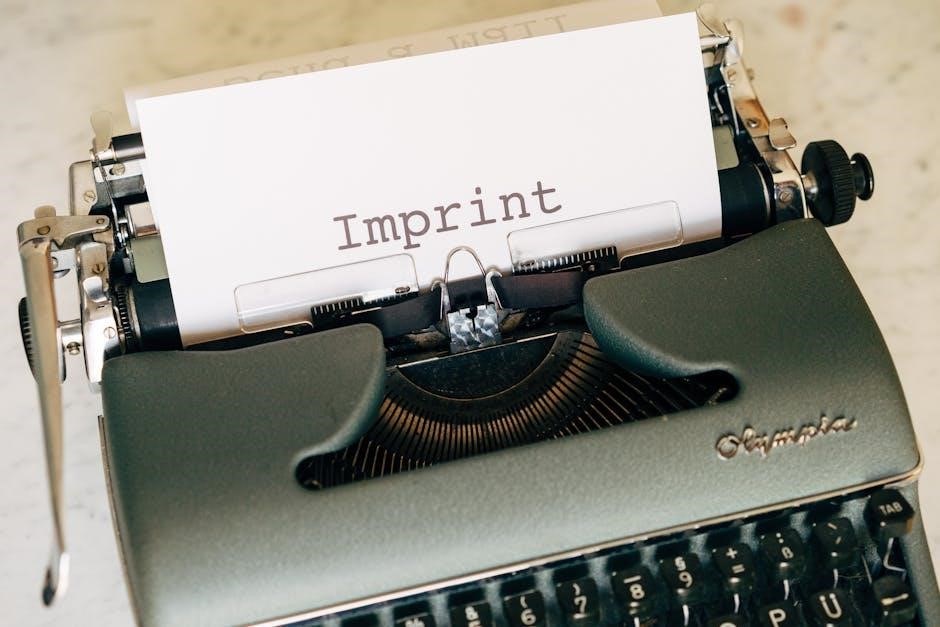Definition and Purpose of Print Manual
A print manual is a document that provides information and instructions on how to use a product or service, with the purpose of educating and guiding users.
The definition of a print manual encompasses a wide range of documents, including user guides, instruction manuals, and product handbooks.
These documents are designed to be easy to understand and follow, using clear language and concise instructions.
The purpose of a print manual is to help users get the most out of a product or service, by providing them with the information they need to use it safely and effectively.
Print manuals are an essential part of many products and services, and are often used in conjunction with other forms of documentation, such as online tutorials and customer support.
They are typically produced using a variety of printing techniques, including digital printing and offset printing, and are often bound in a durable cover to withstand frequent use.
Overall, the definition and purpose of a print manual is to provide users with the information they need to use a product or service successfully.
Importance of Print Manual in Consumer Products
Print manuals play a crucial role in consumer products, as they provide users with essential information and instructions.
The importance of print manuals lies in their ability to educate and guide users, reducing the risk of accidents and injuries.
They also help to increase customer satisfaction, by providing users with a clear understanding of how to use and maintain a product.
In addition, print manuals can help to reduce the number of customer support requests, by providing users with a comprehensive guide to troubleshooting and maintenance.
Overall, the importance of print manuals in consumer products cannot be overstated, as they are a vital component of the user experience.
Print manuals are used in a wide range of consumer products, from electronics and appliances to software and hardware.
They are an essential tool for users, and are often required by law or regulation, to ensure that users are properly informed and protected.

Designing a Great Manual
Organizational Structure and Headings
A logical organizational structure is crucial, with clear and concise headings that help readers locate relevant information quickly and efficiently.
The use of large, numbered headings and subheadings makes it easy to scan the manual and find specific information, while a comprehensive table of contents and index provide additional support.
By organizing the content in a clear and logical manner, print manuals can be made more user-friendly and accessible, reducing confusion and frustration for the reader.
This is particularly important for complex products or systems, where a well-structured manual can make a significant difference in the user’s ability to understand and operate the product successfully.
Overall, a well-organized print manual is essential for effective communication and user satisfaction.
Use of Diagrams and Images in Manual Design
The use of diagrams and images in manual design is a crucial element, as it helps to illustrate complex concepts and instructions, making it easier for readers to understand.
Diagrams and images can be used to show the assembly and disassembly of products, as well as to highlight important safety features and precautions.
The use of color in diagrams and images can also help to draw attention to specific details and make the manual more engaging.
By incorporating diagrams and images, manual designers can create a more visual and intuitive guide, reducing the need for lengthy descriptions and making the content more accessible.
This is particularly important for products with complex components or systems, where diagrams and images can help to clarify the relationships between different parts.
Overall, the use of diagrams and images is an essential aspect of manual design, enhancing the clarity and effectiveness of the content.

Types of Print Manuals
User Manuals and Instruction Manuals
User manuals and instruction manuals are types of print manuals that provide step-by-step instructions for using a product or service. These manuals are typically designed to be easy to follow and understand, with clear headings and concise language. They are often used for complex products or services that require assembly or installation, such as electronics or software. The purpose of user manuals and instruction manuals is to help users understand how to use a product or service safely and effectively. They may also include troubleshooting tips and maintenance instructions to help users resolve common issues. Many companies also provide online versions of user manuals and instruction manuals, which can be accessed through their website or mobile app. Overall, user manuals and instruction manuals play an important role in helping users get the most out of their products or services. They are an essential part of the print manual.
Owner Manuals and Service Manuals
Owner manuals and service manuals are specialized types of print manuals that cater to specific needs. Owner manuals provide detailed information about a product’s features, operation, and maintenance, helping owners understand their product’s capabilities and limitations. Service manuals, on the other hand, are designed for professionals who need to repair or maintain a product, offering in-depth technical information and troubleshooting guides. These manuals are often used for complex products like cars, appliances, and industrial equipment. They may include technical specifications, wiring diagrams, and repair procedures, making them an essential resource for technicians and service personnel. By providing comprehensive information, owner manuals and service manuals help ensure that products are used and maintained correctly, reducing the risk of accidents and prolonging their lifespan. They are a crucial component of the print manual ecosystem.

Printing Process and Materials
Manufacturing and Post-Consumer Waste
Manufacturing print manuals involves considering post-consumer waste, with many companies aiming to reduce their environmental impact by using recycled materials and minimizing waste.
Companies are now using up to 100 post-consumer waste in their printing processes, which helps to reduce the amount of waste sent to landfills.
This approach not only helps to reduce waste but also promotes sustainability and reduces the carbon footprint of the printing process, making it a more environmentally friendly option.
The use of recycled materials and minimal waste is becoming increasingly important in the printing industry, and companies are now expected to prioritize sustainability in their manufacturing processes.
By using recycled materials and reducing waste, companies can help to minimize their environmental impact and promote a more sustainable future for the printing industry.
Smooth Printing Process and Review
To ensure a smooth printing process, it is essential to review the print job carefully before production begins;
This review process involves checking the layout, content, and design of the print manual to ensure that it meets the required standards.
A thorough review helps to identify and correct any errors or inconsistencies, which can delay the printing process or result in a low-quality final product.
By reviewing the print job, companies can ensure that their print manuals are of high quality and meet the needs of their customers.
A smooth printing process and review are critical components of producing high-quality print manuals, and companies should prioritize these steps to ensure the best possible outcome.
Reviewing the print job helps to prevent errors and ensures that the final product is accurate and effective in communicating the intended information.

Special Considerations for Print Manuals
When creating print manuals, there are several special considerations that must be taken into account.
One of these considerations is the target audience and the level of technical expertise they possess.
The language and terminology used in the manual should be clear and concise, avoiding jargon and technical terms that may be unfamiliar to the reader.
Additionally, the manual should be designed to be accessible to readers with disabilities, with features such as large print and high contrast colors.
Companies must also consider the costs associated with printing and distributing the manuals, as well as the environmental impact of the printing process.
By taking these special considerations into account, companies can create print manuals that are effective, accessible, and environmentally responsible, providing value to their customers and supporting their business goals.
This requires careful planning and attention to detail to ensure the best possible outcome.

No Responses